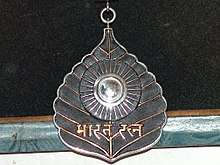K. Kamaraj
Kumaraswami Kamaraj (15 July 1903[1] – 2 October 1975[2]), was the founder and the president of the Indian National Congress (Organisation), widely acknowledged as the "Kingmaker" in Indian politics during the 1960s. He also served as the president of the Indian National Congress for two terms i.e. four years between 1964–1967 and was responsible for the elevation of Lal Bahadur Shastri to the position of Prime Minister of India after Nehru's death and Indira Gandhi after Shastri's death. Kamaraj was the 3rd Chief Minister of Madras State (Tamil Nadu) during 1954–1963 and a Member of Parliament, Lok Sabha during 1952–1954[3] and 1969–1975. He was known for his simplicity and integrity. He played a major role in developing the infrastructure of the Madras state and worked to improve the quality of life of the needy and the disadvantaged.[1][4]
K. Kamaraj | |
|---|---|
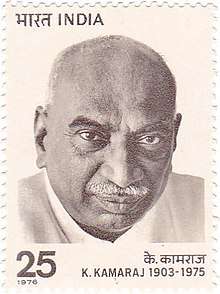 K. Kamaraj commemorative stamp | |
| 3rd Chief Minister of Madras State | |
| In office 13 April 1954 – 2 October 1963 | |
| Governor | Sri Prakasa, A. J. John, P. V. Rajamannar (Acting), Bhishnuram Medhi |
| Preceded by | C. Rajagopalachari |
| Succeeded by | M. Bhakthavatsalam |
| Constituency | Gudiyatham (1954-1957) and Sattur (1957-1963) |
| Member of Parliament, Lok Sabha | |
| In office 9 January 1969 – 2 October 1975 | |
| Prime Minister | Indira Gandhi |
| Preceded by | A. Nesamony |
| Succeeded by | Kumari Ananthan |
| Constituency | Nagerkovil |
| In office 13 May 1952 – 12 April 1954 | |
| Prime Minister | Jawaharlal Nehru |
| Preceded by | position established |
| Succeeded by | U. Muthuramalingam Thevar |
| Constituency | Thiruvillipuththur |
| President of Indian National Congress (Organisation) | |
| In office 12 November 1969 – 2 October 1975 | |
| Preceded by | position established |
| Succeeded by | Morarji Desai |
| President of the Indian National Congress | |
| In office 1964–1967 | |
| Preceded by | Neelam Sanjiva Reddy |
| Succeeded by | S. Nijalingappa |
| President of the Madras Provincial Congress Committee | |
| In office 1946–1952 | |
| Succeeded by | P. Subbarayan |
| Personal details | |
| Born | Kumaraswami Kamaraj 15 July 1903 Virudhunagar, Madras Presidency, British India (present-day Tamil Nadu, India) |
| Died | 2 October 1975 (aged 72) Madras, Tamil Nadu, India (present-day Chennai) |
| Cause of death | Heart Attack |
| Resting place | Perunthalaivar Kamarajar Ninaivagam |
| Nationality | Indian |
| Political party | Indian National Congress (Organisation) |
| Other political affiliations | Indian National Congress (until 1969) |
| Residence | Kamaraj Illam 1/10, Thyagaraya Nagar, Chennai, Tamil Nadu, India |
| Awards |
|
| Signature | |
He was involved in the Indian independence movement.[5] As the president of the INC, he was instrumental in navigating the party after the death of Jawaharlal Nehru. As the chief minister of Madras, he was responsible for bringing free education to the disadvantaged and introduced the free Midday Meal Scheme while he himself did not complete schooling. He was awarded with India's highest civilian honour, the Bharat Ratna, posthumously in 1976.[6]
Early life
Kamaraj was born on 15 July 1903 in Virudhunagar, Tamil Nadu, to Kumaraswami Nadar and Sivakami Ammal. His name was originally Kamatchi, later changed to Kamarajar. His father Kumaraswami was a merchant. Kamaraj had a younger sister named Nagammal.[7][8] Kamaraj was first enrolled in a traditional school in 1907 and in 1908 he was admitted to Yenadhi Narayana Vidhya Salai. In 1909 Kamaraj was admitted in Virudupatti High School. Kamaraj's father died when he was six years old, his mother was forced to support the family. In 1914 Kamaraj dropped out of school to support his mother.[9]
Politics
As a young boy, Kamaraj worked in his uncle's provision shop and during that time he began to attend public meetings and processions about the Indian Home Rule Movement. Kamaraj developed an interest in prevailing political conditions by reading newspapers daily. The Jallianwala Bagh massacre was the decisive turning point in his life - he decided to fight for national freedom and to bring an end to foreign rule.[10][11] In 1920, when he was 18, he became active in politics. He joined Congress as a full-time political worker.[11] In 1921 Kamaraj organised public meetings at Virudhunagar for Congress leaders. He was eager to meet Gandhi, and when Gandhi visited Madurai on 21 September 1921 Kamaraj attended the public meeting and met Gandhi for the first time. He visited villages carrying Congress propaganda.[10]
In 1922 Congress boycotted the visit of the Prince of Wales as part of the Non-Cooperation Movement. He came to Madras and took part in the event.[12] In 1923–25 Kamaraj participated in the Nagpur Flag Satyagraha.[13] In 1927, Kamaraj started the Sword Satyagraha in Madras and was chosen to lead the Neil Statue Satyagraha, but this was given up later in view of the Simon Commission boycott.[14]
Kamaraj went to jail for two years in June 1930 for participating in the "Salt Satyagraha".[15] led by Rajagopalachari at Vedaranyam; he was released before he served the two year sentence as a result of 1931 Gandhi-Irwin Pact. In 1932, Section 144 was imposed in Madras prohibiting the holding of meetings and organisation of processions against the arrest of Gandhi in Bombay. In Virdhunagar, under Kamaraj's leadership, processions and demonstrations happened every day. Kamaraj was arrested again in January 1932 and sentenced to one year's imprisonment.[16] In 1933 Kamaraj was falsely charged in the Virudhunagar bomb case. Varadarajulu Naidu and George Joseph argued on Kamaraj's behalf and proved the charges to be baseless.[17] At the age of 34, Kamaraj entered the Assembly winning the Sattur seat in the 1937 election.[18]
Kamaraj conducted a vigorous campaign throughout the state asked people not to contribute to war funds when Sir Arthur Hope, the Madras Governor, was collecting contributions to fund for the Second World War. In December 1940 he was arrested again at Guntur, under the Defence of India rules for speeches that opposed contributions to the war fund, and sent to Vellore Central Prison while he was on his way to Wardha to get Gandhi's approval for a list of Satyagrahis. While in jail, he was elected as Municipal Councillor of Virudhunagar. He was released nine months later in November 1941 and resigned from this post as he thought he had greater responsibility for the nation. [19][20] His principle was "One should not accept any post to which one could not do full justice".[21]
In 1942, Kamaraj attended the All-India Congress Committee in Bombay and returned to spread propaganda material for the Quit India Movement. The police issued orders to all the leaders who attended this Bombay session. Kamaraj did not want to be arrested before he took the message to all district and local leaders. finishing his work and sent a message to the local police that he was ready to be arrested. He was arrested in August 1942. He was under detention for three years and was released in June 1945. This was his last prison term.[15][19][22] Kamaraj was imprisoned six times by the British for his pro-Independence activities, that added up to more than 3,000 days in jail.[23]
Chief Minister
On 13 April 1954, Kamaraj became the Chief Minister of Madras Province. To everyone's surprise, Kamaraj nominated C. Subramaniam and M. Bhakthavatsalam, who had contested his leadership, to the newly formed cabinet.
As Chief Minister, Kamaraj removed the family vocation based Hereditary Education Policy introduced by Rajaji. The State made immense strides in education and trade. New schools were opened, so that poor rural students had to walk no more than three kilometres to their nearest school. Better facilities were added to existing ones. No village remained without a primary school and no panchayat without a high school. Kamaraj strived to eradicate illiteracy by introducing free and compulsory education up to the eleventh standard. He introduced the Midday Meal Scheme to provide at least one meal per day to the lakhs of poor school children. Later it was expanded to four more schools. This was the precursor to the free noon meal schemes introduced by K. Kamaraj in 1960's and expanded by M. G. Ramachandran in the 1980s.. He introduced free school uniforms to weed out caste, creed and class distinctions among young minds.

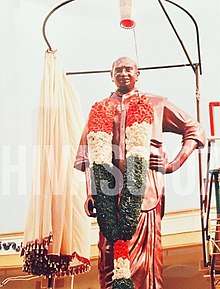
During the British regime the education rate was only 7%. But after Kamaraj's reforms it reached 37%. Apart from increasing the number of schools, steps were taken to improve standards of education. To improve standards, the number of working days was increased from 180 to 200; unnecessary holidays were reduced; and syllabi were prepared to give opportunity to various abilities. Kamaraj and Bishnuram Medhi (Governor) took efforts to establish IIT Madras in 1959.
Major irrigation schemes were planned in Kamaraj's period. Dams and irrigation canals were built across higher Bhavani, Mani Muthar, Aarani, Vaigai, Amaravathi, Sathanur, Krishnagiri, Pullambadi, Parambikulam and Neyyaru among others. The Lower Bhavani Dam in Erode district brought 207,000 acres (840 km2) of land under cultivation. 45,000 acres (180 km2) of land benefited from canals constructed from the Mettur Dam. The Vaigai and Sathanur systems facilitated cultivation across thousands of acres of lands in Madurai and North Arcot districts respectively. Rs 30 crores were planned to be spent for Parambikulam River scheme, and 150 lakhs of acres of lands were brought under cultivation; one third of this (i.e. 56 lakhs of acres of land) received a permanent irrigation facility. In 1957–61 1,628 tanks were de-silted under the Small Irrigation Scheme, and 2,000 wells were dug with outlets. Long term loans with 25% subsidy were given to farmers. In addition farmers who had dry lands were given oil engines and electric pump sets on an instalment basis.
Industries with huge investments in crores of Rupees were started in his period: Neyveli Lignite Corporation, BHEL at Trichy, Manali Refinery, Hindustan raw photo film factory at Ooty, surgical instruments factory at Chennai, and a railway coach factory at Chennai were established. Industries such as paper, sugar, chemicals and cement took off during the period.
First Cabinet
Kamaraj's council of ministers during his first tenure as Chief Minister (13 April 1954 – 31 March 1957):[24]
| Minister | Portfolios |
|---|---|
| K. Kamaraj | Chief Minister, Public and Police in the Home Department |
| M. Bhaktavatsalam | Agriculture, Forests, Fisheries, Cinchona, Rural Welfare, Community Projects, National Extension Scheme, Women’s Welfare, Industries and Labour, Animal Husbandry and Veterinary |
| C. Subramaniam | Finance, Food, Education, Elections and Information, Publicity and Law (Courts and Prisons) |
| A. B. Shetty | Medical and Public Health, Co-operation, Housing, Ex-servicemen. |
| M. A. Manickavelu Naicker | Land Revenue, Commercial Taxes, Rural Development |
| Shanmugha Rajeswara Sethupathi | Public Works, Accommodation Control, Engineering Colleges, Stationery and Printing including establishment questions of the Stationery Department and the Government Press |
| B. Parameswaran | Transport, Harijan Uplift, Hindu Religious Endowments, Registration, Prohibition |
| S. S. Ramasami Padayachi | Local Administration |
- Changes
Following the States Reorganisation Act of 1956, A. B. Shetty quit the Ministry on 1 March 1956 and his portfolio was shared between the other ministers.
Second Cabinet
Kamaraj's council of ministers during kamarajars second tenure as Chief Minister (1 April 1957 – 1 March 1962):[25]
| Minister | Portfolios |
|---|---|
| K. Kamaraj | Chief Minister, Public Planning and Development (including Local Development Works, Women's Welfare, Community Projects and Rural Welfare), National Extension Scheme |
| M. Bhaktavatsalam | Home |
| C. Subramaniam | Finance |
| R. Venkataraman | Industries |
| M. A. Manickavelu Naicker | Revenue |
| P. Kakkan | Works |
| V. Ramaiah | Electricity |
| Lourdhammal Simon | Local Administration |
Third Cabinet
Kamaraj's council of ministers during his third tenure as Chief Minister (3 March 1962 – 2 October 1963):[25][26][27]
| Minister | Portfolios |
|---|---|
| K. Kamaraj | Chief Minister, Public Planning and Development (including Local Development Works, Women's Welfare, Community Projects and Rural Welfare), National Extension Scheme |
| M. Bhaktavatsalam | Finance and Education |
| Jothi Venkatachalam | Public Health |
| R. Venkataraman | Revenue |
| S. M. Abdul Majid | Local Administration |
| N. Nallasenapathi Sarkarai Mandradiar | Cooperation, Forests |
| G. Bhuvaraghan | Publicity and Information |
Kamaraj Plan
Kamaraj remained Chief Minister for three consecutive terms, winning elections in 1957 and 1962. Kamaraj noticed that the Congress party was slowly losing its vigour.
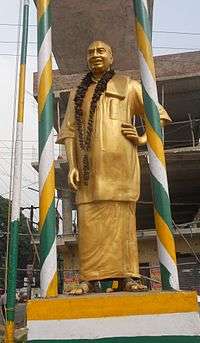
On Gandhi Jayanti day 2 October 1963, he resigned from the post of the Chief Minister. He proposed that all senior Congress leaders should resign from their posts and devote all their energy to the re-vitalization of the Congress.
In 1963 he suggested to Nehru that senior Congress leaders should leave ministerial posts to take up organisational work. This suggestion came to be known as the Kamaraj Plan, which was designed primarily to dispel from the minds of Congressmen the lure of power, creating in its place a dedicated attachment to the objectives and policies of the organisation. Six Union Ministers and six Chief Ministers including Lal Bahadur Shastri, Jagjivan Ram, Morarji Desai, Biju Patnaik and S.K. Patil followed suit and resigned from their posts. Impressed by Kamaraj's achievements and acumen, Prime Minister Jawaharlal Nehru felt that his services were needed more at the national level. In a swift move he brought Kamaraj to Delhi as the President of the Indian National Congress. Nehru realised that in addition to wide learning and vision, Kamaraj possessed enormous common sense and pragmatism. Kamaraj was elected the President of Indian National Congress on 9 October 1963.[28]
National politics
After Nehru's death in 1964, Kamaraj successfully navigated the party through turbulent times. As the president of INC, he refused to become the next Prime Minister himself and was instrumental in bringing to power two Prime Ministers, Lal Bahadur Shastri in 1964 and Nehru's daughter Indira Gandhi in 1966.[29] For this role, he was widely acclaimed as the "kingmaker" during the 1960s.[30]
When the Congress split in 1969, Kamaraj became the leader of the Indian National Congress (Organisation) (INC(O)) in Tamil Nadu. The party fared poorly in the 1971 elections amid allegations of fraud by the opposition parties. He remained the leader of INC(O) until his death in 1975.[31]
Electoral history
| Year | Post | Constituency | Party | Opponent | Election | Result |
|---|---|---|---|---|---|---|
| 1937 | MLA | Sattur | INC | Unopposed | 1937 elections | Won |
| 1946 | MLA | Sattur-Aruppukottai | INC | Unopposed | 1946 elections | Won |
| 1952 | MP | Srivilliputtur | INC | G. D. Naidu | Indian General Elections, 1951 | Won |
| 1954 | MLA | Gudiyatham | INC | V. K. Kothandaraman | By Election | Won |
| 1957 | MLA | Sattur | INC | Jayarama Reddiar | 1957 Madras legislative assembly election | Won |
| 1962 | MLA | Sattur | INC | P. Ramamoorthy | 1962 Madras legislative assembly election | Won |
| 1967 | MLA | Virudhunagar | INC | P. Seenivasan | 1967 Tamil Nadu state assembly election | Lost |
| 1969 | MP | Nagercoil | INC | M. Mathias | By Election | Won |
| 1971 | MP | Nagercoil | INC(O) | M. C. Balan | Indian General Elections, 1971 | Won |
Personal life
During his tenure as Chief Minister, when the municipality of Virudhunagar provided a direct water connection to his house in his hometown, Kamarajar ordered it to be disconnected immediately as he did not want any special privileges. He refused to use the Z-level security that was provided to him as the CM of Tamil Nadu and instead travelled with just one police patrol vehicle. He did not marry, did not own any property and was never tempted by power.[8] When he died, he left behind 130 rupees, 2 pairs of sandals, 4 shirts, 4 dhotis and a few books.[32]
Death
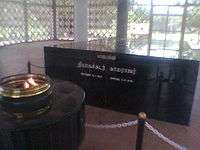
Kamaraj died at his home, on Gandhi Jayanti day (2 October 1975), which also was the 12th anniversary of his resignation. He was aged 72 and died in his sleep due to a heart attack.[33]
Legacy
Kamaraj was awarded India's highest civilian honour, the Bharat Ratna, posthumously in 1976. The domestic terminal of the Chennai airport is named "Kamaraj Terminal". Marina beach road in Chennai was named as "Kamarajar Salai". North Parade Road in Bengaluru and Parliament road in New Delhi were also renamed after Kamaraj. Madurai Kamaraj University is named in his honour.[4][34] In 2003, the Government of India released a commemorative coin on his birthday.
Popular culture
In 2004 a Tamil-language film titled Kamaraj was made based on the life history of Kamaraj.[35] The English version of the film was released on DVD in 2007.
References
- Revised edition of book on Kamaraj to be launched Archived 10 May 2011 at the Wayback Machine The Hindu, 8 July 2009
- Crusading Congressman, Frontline Magazine Archived 15 September 2008 at the Wayback Machine, hinduonnet.com. 15–28 September 2001
- LOK SABHA DEBATES (PDF). Government of India. p. 22. Retrieved 8 April 2020.
- He raised the bar with simplicity. The Hindu. 16 July 2008 Archived 10 May 2011 at the Wayback Machine
- The commonsense politician, Frontline Magazine, 17–30 August 2002 Archived 28 July 2011 at the Wayback Machine
- "Padma Awards Directory (1954–2007)" (PDF). Ministry of Home Affairs. Archived from the original (PDF) on 4 March 2009. Retrieved 7 December 2010.
- "A Brief Personal and Political Biography of Kamaraj Early Life" (PDF).
- "In dire straits, Kamaraj kin get Congress aid for education - Times of India". The Times of India. Retrieved 19 January 2019.
- Kapur, Raghu Pati (1966). Kamaraj, the iron man. Deepak Associates. p. 12. Archived from the original on 16 November 2014.
- Early Life of K. Kamaraj. Concept Publishing Company. pp. 24–25.
- Venkatesan, P. and Sivakumar, N. (2012). "Freedom Movement In Madras Presidency With Special Reference To The Role Of Kamaraj (1920–1945)". Indian Streams Research Journal. 2 (7): 1.CS1 maint: multiple names: authors list (link)
- {{|date=May 2019|bot=medic}}
- K.Kamaraj. virudhunagar.nic.in Archived 7 October 2014 at the Wayback Machine
- Kandaswamy, P. (2001). The Political Career of K. Kamaraj. Concept Publishing Company. p. 30.
- Bhatnagar, R. K. (13 October 2009). "Tributes To Kamaraj". Asian Tribune. Archived from the original on 21 February 2014. Retrieved 3 February 2014.
- Freedom Movement In Madras Presidency With Special Reference To The Role Of Kamaraj (1920–1945), Page 3
- George Joseph, a true champion of subaltern Archived 26 January 2016 at the Wayback Machine
- "K Kamaraj 116th birth anniv: Rare pics of 'Kingmaker'". Deccan Herald. 15 July 2019. Retrieved 22 May 2020.
- Remembering Our Leaders. Children's Book Trust. 1989. p. 146. ISBN 978-81-7011-767-4.
- Encyclopedia of Bharat Ratnas. Pitambar Publishing. p. 88. ISBN 978-81-209-1307-3.
- Sain, Pravina Bhim (1989). Remembering our leaders. New Delhi. p. 146. ISBN 81-7011-545-0. OCLC 422855040.
- Encyclopedia of Bharat Ratnas. Pitambar Publishing. p. 89. ISBN 978-81-209-1307-3.
- Stepan, Alfred; Linz, Juan J.; Yadav, Yogendra (2011). Crafting State-Nations: India and Other Multinational Democracies. JHU Press. p. 124. ISBN 9780801897238.
- A Review of the Madras Legislative Assembly (1952–1957) Archived 17 October 2013 at the Wayback Machine
- Kandaswamy, P. (2001). The Political Career of K. Kamaraj. Concept Publishing Company. pp. 62–64. Archived from the original on 31 July 2017.
- The Madras Legislative Assembly, Third Assembly I Session Archived 14 May 2011 at the Wayback Machine
- The Madras Legislative Assembly, Third Assembly II Session Archived 14 May 2011 at the Wayback Machine
- K Kamaraj. dpcc.co.in Archived 18 May 2012 at the Wayback Machine
- "Will Mamata Banerjee's Hindi handicap hurt her ambition to be prime minister?". Archived from the original on 2 December 2016.
- Khan, Farhat Basir (16 September 2019). The Game of Votes: Visual Media Politics and Elections in the Digital Era. SAGE Publishing India. p. 76. ISBN 978-93-5328-693-4.CS1 maint: date and year (link)
- Gopal, Madan (1990). K.S. Gautam (ed.). India through the ages. Publication Division, Ministry of Information and Broadcasting, Government of India. p. 164.
- Pioneer, The. "To regain lost glory, Congress needs a Kamaraj as its leader". The Pioneer.
- Times, Kashturi Rangan Special to The New York (3 October 1975). "Kumaraswami Kamaraj Dead; Power Broker in Indian Politics". The New York Times. ISSN 0362-4331. Retrieved 28 April 2020.
- Man of the people Archived 6 September 2008 at the Wayback Machine, The Tribune, 4 October 1975
- "Film on former CM Kamaraj to be re-released with additional content' - Times of India". The Times of India. 16 January 2017. Retrieved 24 March 2020.
External links
| Wikimedia Commons has media related to K. Kamaraj. |
